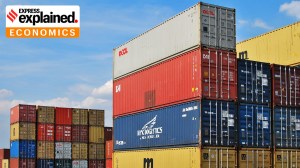- India
- International
UPSC Essentials: One word a day – OPEC+, an international organisation
What is OPEC+? Know about this word often seen in news. Explore beyond the word to briefly understand three related essential questions for prelims or mains. Don't miss the MCQ and Post Read Q&A.
 OPEC's objective is to co-ordinate and unify petroleum policies among member countries (File photo, source: Reuters)
OPEC's objective is to co-ordinate and unify petroleum policies among member countries (File photo, source: Reuters)Take a look at the essential concepts, terms, and phenomena from the static and current parts of the UPSC-CSE. The Post Read Q&A will help you to self-evaluate your retention memory after reading the article.
Word: OPEC+
Subject: International Organisations
Relevance: International organizations in news are essential for prelims and mains both. Since this organization is related to the energy sector and has an impact on India too, we go deep to look at three questions in the Beyond the word sub-section. Try solving the MCQ and point to ponder.
—The grouping of the world’s largest oil-producing countries, the Organisation of the Petroleum Exporting Countries (OPEC) and its allies, together known as OPEC+, decided to cut oil production by 2 million barrels per day (bpd) on Wednesday (October 5).
—This is the largest cut since the beginning of the Covid-19 pandemic. Brent crude, the international benchmark, was up 28 cents or 0.3%, at $92.08 a barrel after the cut was announced, reported Reuters.
—In light of recent falling gas prices, OPEC+ officials had decided in September to reduce oil output by a modest 100,000 bpd after they first agreed in the previous month to increase production by the same amount.
What is OPEC+?

—Established in 1960 by founding members Iran, Iraq, Kuwait, Saudi Arabia and Venezuela, OPEC has since expanded and now has 13 member states. Iran, Iraq, Kuwait, United Arab Emirates(UAE), Saudi Arabia, Algeria, Libya, Nigeria, Gabon, Equatorial Guinea, Republic of Congo, Angola, and Venezuela are members of OPEC.
—Ecuador suspended its membership in December 1992, rejoined OPEC in October 2007, but decided to withdraw its membership of OPEC effective 1 January 2020. Qatar terminated its membership on 1 January 2019.
—With the addition of another 11 allied major oil-producing countries that include Russia, the grouping is known as OPEC+.
—The objective of the organisation is to “coordinate and unify the petroleum policies of its Member Countries and ensure the stabilisation of oil markets in order to secure an efficient, economic and regular supply of petroleum to consumers, a steady income to producers and a fair return on capital for those investing in the petroleum industry,” according to the OPEC website.
—It is headquartered in Vienna, Austria. OPEC membership is open to any country that is a substantial exporter of oil and which shares the ideals of the organization.
—OPEC’s formation by five oil-producing developing countries in Baghdad in September 1960 occurred at a time of transition in the international economic and political landscape, with extensive decolonisation and the birth of many new independent states in the developing world.
—Previously controlled by western-dominated multinational oil companies known as the “Seven Sisters,” OPEC sought to give the oil-producing nations greater influence over the global petroleum market. They account for roughly 40 per cent of the world’s crude oil and 80 per cent of the globe’s oil reserves, according to estimates from 2018. They usually meet every month to determine how much oil the member states will produce.
—However, many allege that OPEC behaves like a cartel, determining the supply of oil and influencing its price in the world market.
Why are they slashing production?
—Oil prices skyrocketed after Russia’s invasion of Ukraine in February, and have since begun to soften over the past few months, before dropping sharply to under $90 in September due to fears of a recession in Europe and reduced demands from China because of its lockdown measures.
—Today’s cut is the biggest of its kind since 2020 when OPEC+ members slashed outputs by 10 million bpd during the Covid-19 pandemic, Reuters reported. The reductions would boost prices and be extremely beneficial for the Middle Eastern member states, to whom Europe has turned for oil after levelling sanctions against Russia since it invaded Ukraine.
—OPEC+ members are concerned that a faltering global economy would reduce the demand for oil, and the cuts are seen as a way to protect profits. Increased oil prices, which first occurred during the invasion of Ukraine, have helped Saudi Arabia, one of the founding members of OPEC, become one of the world’s fastest-growing economies, according to The Wall Street Journal.
—The New York Times raised the possibility that Moscow might be influencing OPEC, to make it more expensive for the West to extend energy sanctions on Russia. “To the extent that prices rise, it will make it that much more challenging for Europe to proceed with its sanctions on Russian oil in December,” said Bhushan Bahree, an executive director of S&P Global Commodity Insights.
Who is against this decision?
—Within the group, there are those that are opposed to such significant cuts in oil production, and according to The Wall Street Journal, a meeting of OPEC+ technocrats was cancelled on Tuesday because of disagreements that reportedly only a gathering of oil ministers could resolve. The United Arab Emirates (UAE) and Kuwait, in particular, are said to be concerned that extended cuts would interfere with their plans to increase oil output capacity.
—The move is likely to be highly detrimental to the US, which has repeatedly asked the organisation to increase oil production. President Joe Biden had travelled to Saudi Arabia in July, a country he had pledged to make into a “pariah” for its alleged role in the assassination of The Washington Post columnist Jamal Khashoggi, partly to request more oil. The modest increase of 100,000 bpd in August has since been replaced by attempts to reduce production by Saudi Arabia.
—Slashes in reduction and subsequently increased oil prices can be particularly dangerous to Biden, who is trying to reduce inflation rates before the midterm elections in November. Over the past few days, Biden administration’s senior officials have been lobbying their counterparts in Kuwait, Saudi Arabia and the UAE to vote against reducing oil production, sources told CNN.
—The US has not publicly accepted these attempts, however. White House press secretary Karine Jean-Pierre on Friday told reporters that the US is not part of OPEC+ and did not reveal any attempts made by her administration, as reported by The Wall Street Journal. “They are an independent entity and we allow them to make their news and their announcements on their own,” she said.
Beyond the word: Three questions
What should Indian decision-makers do today to respond to such a uncertain future of the international petroluem market?
Vikram S Mehta chairman and senior fellow, Brookings India have the following four suggestions.
—One, it should fill the oil caverns with strategic reserves. Prices may fall further but rather than bottom fish, it should leverage the availability of capacity to secure discounted supplies. The world has run out of storage capacity and producers may pay premium dollar to find space for their unsold cargoes.
—Second, it should increase its imports of gas (LNG ) from Australia, Africa and the US. This will reduce the political risks of dependency on oil supplies from the Middle East. Gas is also now economically competitive. The landed price of LNG is low enough to kick-start some of the stranded gas-based power plants.
—Third, it should unthread the “patchwork quilt of authority” exercised by bureaucrats, regulators and politicians, which today stifles management and operational efficiency of the petroleum companies.
—And finally, it should create an institutional basis for an integrated energy policy. If there is one message we must internalise from COVID, it is the importance of collaboration and coordination.
What are India’s strategic petroleum reserves, and why are they needed?
—India’s strategic reserves are the effort of a broader plan to build an emergency stockpile with millions of barrels of crude oil, on the lines of the reserves that the US and its Western allies set up after the first oil crisis of 1973-74. Under the first stage of the Strategic Petroleum Reserve project, underground rock caverns with total storage of 5.33 MMT, or about 38 million barrels of crude oil, have been commissioned at three locations — Visakhapatnam (1.33 MMT), Mangalore (1.5 MMT), and Padur in Karnataka (2.5 MMT).
—These facilities can provide for about 9.5 days of India’s crude oil requirements based on 2019-20 consumption levels. The combined storage facilities of Oil Marketing Companies (OMCs) in the country can hold enough crude oil to meet 64.5 days of requirement, bringing the total national capacity for storage of crude oil and petroleum products to 74 days, according to the Centre. India is in the process of expanding its strategic petroleum reserve storage by 6.5 MMT at two locations — Chandikhol in Odisha (4 MMT) and Padur (2.5 MMT).
—The International Energy Agency (IEA) recommends that all countries hold crude oil stocks worth 90 days of imports. India imports about 85 per cent of its crude oil requirements. Crude oil from the reserves are to be released by an empowered committee constituted by the government, in the event of any supply disruptions from abroad. These include any natural calamity or unforeseen global event leading to an abnormal increase in prices.
—India decided to release 5 million barrels of oil from its strategic reserves as part of a coordinated challenge led by the US against the OPEC+ producers’ cartel’s move to curb output, was the first time that New Delhi dipped into its reserves to leverage it as a geopolitical tool. A senior government official said that this was the first instance of India using strategic reserves to influence international prices.
What is IEA?
—The International Energy Agency (IEA) is an autonomous organisation with its headquartered in Paris, France.
—It works to ensure reliable, affordable and clean energy.
—Its genesis can be traced back to 1973 (set up in 1974) oil crisis after the world witnessed a steep increase in oil prices due to the OPEC cartel. The IEA is made up of 31 member countries and 8 association countries.
—The IEA has four main areas of focus, i.e. 4Es: Energy security, Economic development, Environmental awareness and Engagement worldwide.
—India became an associate member of the International Energy Agency in 2017.
Point to ponder: India has emerged as a major buyer of Russian crude but what are some caution in order?
MCQ:
Consider the following countries
1.Iran
2.Iraq
3.UAE
4.Qatar
5.USA
6.Russia
Which of the above countries are part of OPEC or OPEC+?
a) 1,2,3,6
b) 2,3,4,6
c) 1,3,4,5,6
d) 1,2,3,4
(sources: opec.org, iea.org)
Post Read Q&A
Can you recall what you read?
- Which countries are part of OPEC+?
- How should Indian decision makers respond to the uncertainities of international petroleum market?
- How are IEA and OPEC related?
Apr 18: Latest News
- 01
- 02
- 03
- 04
- 05






































